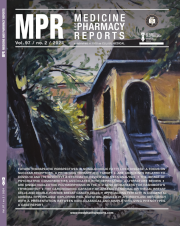The carcinogenic capacity of arsenic in normal epithelial breast cells and double-positive breast cancer cells
DOI:
https://doi.org/10.15386/mpr-2682Keywords:
arsenic, breast cancer, heavy metals, carcinogenic, DNA mutationsAbstract
Background and aims. The carcinogenic effect of arsenic is a subject of controversy in relation to breast cancer. In our current research, we aimed to simulate the effects of chronic low-level arsenic exposure on breast cells by intoxicating MCF-10A and MCF-7 cells with 1 μM Arsenic trioxide (As2O3) for 3 weeks (3w) and 6 weeks (6w), respectively.
Methods. We assessed the cellular responses to As2O3 through various assays, including confocal fluorescence microscopy, flow cytometry for cell cycle analysis, Transwell invasion assay, scratch assay, and colony assay. Additionally, we analyzed the mutation burden in all the exposed cells by using the next generation sequencing technology.
Results. Our findings indicate that As2O3 has a minor carcinogenic effect in normal cells, with no definitive evidence of malignant transformation observed after 6 weeks of exposure. In the case of breast cancer cells, As2O3 exhibits a dual effect, both inhibitory and stimulatory. It leads to reduced colony formation ability at 6 weeks, while enhancing the cells’ ability for invasion. The mutations triggered by As2O3 exposure are distributed across genes with both tumor-suppressive and oncogenic functions. Five mutations are common to both cell lines, involving the following genes: Kinase Insert Domain Receptor (KDR) (c.798+54G>A), Colony Stimulating Factor 1 Receptor (CSF1R) (c.*37AC>C, c.*35C>TC), SWI/SNF-Related Matrix-Associated Actin-Dependent Regulator of Chromatin Subfamily B Member 1 (SMARCB1) (c.1119-41C>T), and Fms-like Tyrosine Kinase 3 (FLT3) (c.1310-3T>C). Additionally, Human Epidermal Growth Factor Receptor 4 (ERBB4/HER4) (c.421+58A>G) and Human Epidermal Growth Factor Receptor 2 (HER2/ERBB2) (c.2307+46A>G) mutations were exclusively found in MCF-10A cells exposed to As2O3. Furthermore, MCF-7 cells exhibited unique mutations in the KIT Proto-Oncogene (KIT) (c.1594G>A) and TP53 (c.215C>G).
Conclusion. In summary, our study reveals that a 6-weeks exposure to arsenic has a limited carcinogenic effect in normal breast cells and a dual role in breast cancer cells.
Downloads
Published
How to Cite
Issue
Section
License
The authors are required to transfer the copyright of the published paper to the journal. This is done by agreeing to sign the Copyright Assignment Form. Whenever the case, authors are also required to send permissions to reproduce material (such as illustrations) from the copyright holder.

The papers published in the journal are licensed under a Creative Commons Attribution-NonCommercial-NoDerivatives 4.0 International License.

